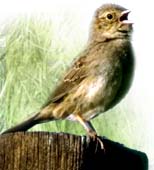Shortgrass Bird
Conservation Region
Conservation Issues
As is the case in many other areas, the driving conservation issues in the
shortgrass prairie are habitat loss and habitat alteration. Although human
populations are comparatively low throughout much of the region, they are
growing, and the accompanying land development is responsible for much of the
habitat conversion. Within the BCR, urbanization is concentrated in Colorado's
Front Range counties, some of the fastest-growing in the nation. Population
densities there exceed 4,000 people/miČ, whereas population densities in some
remote counties of the region are less than 1 person/miČ.
Because much of the shortgrass prairie is too dry to farm without irrigation,
the amount of plowed land is not high and much of the region is still
grassland. In Colorado, which has the biggest chunk of the BCR among the eight
states, about 70% of the historical shortgrass prairie still exists, with the
rest converted to cropland and urban developments. However, some sources
suggest that only 20% still resembles the original, unaltered prairie, with the
other 80% converted to other land cover types or seriously degraded by
overgrazing.
Ideally, modern management would replicate the timing, intensity, and landscape
distribution of the natural disturbances that shaped the shortgrass prairie
(unfortunately, detailed information about presettlement conditions is
lacking). In practice, however, modern agriculture tends to spread out grazing
intensity evenly, producing a comparatively homogeneous landscape. For the
purposes of bird conservation, some grassland parcels should be grazed heavily
and others not at all, to replicate the heterogeneous landscape historically
created by climate and native species grazing.
Population declines among shortgrass bird species have been largely overlooked
by the conservation community until recently, due in part to widespread concern
about population declines among Neotropical migrant bird species of the eastern
deciduous forest. The result of this redirected focus is that grasslands are
now arguably the highest bird conservation priority on the continent, as
grassland bird species are declining faster than any other group of North
American birds.
Associated Species
An important component of the shortgrass prairie ecosystem is the prairie dog.
The species inhabiting the shortgrass prairie, the black-tailed prairie dog (Cynomys
ludovicianus
), was recently proposed for listing under the Endangered Species Act. The
proposal came about because the species' current range represents only about 2%
of the presettlement range. It is absent from the other 98% of its historic
range because of the combined effects of habitat conversion, control activities
for agricultural purposes, and plague (an introduced disease). Habitat
fragmentation has contributed, also, as many colonies are now separated by
large expanses of cropland or other inhospitable land cover types, and prairie
dogs have limited dispersal ability. Because of their vital role in habitat
creation (very important for species such as Burrowing Owl and Mountain
Plover), their decline may have been followed by declines of some shortgrass
bird species.
Winter Range Issues
Efforts to address winter range issues are hampered by our ignorance of
wintering bird distribution and ecology in Central and South America.
Urbanization, overgrazing, and other forces of habitat conversion are probably
contributing to population declines of some species, but much work remains to
be done to identify all contributing factors.



